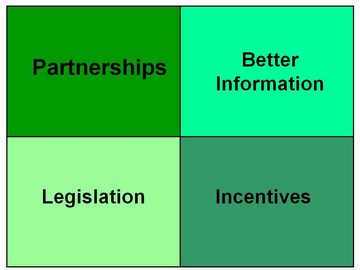BC’s Green Communities Initiative helps local governments create “integrated communities”

Green Communities context for Comox Valley Learning Lunch Seminar Series
The Green Communities Initiative provides a comprehensive framework for helping local governments in BC create integrated communities. The Green Communities framework has four elements:
- partnerships,
- better information,
- legislation and
- incentives.
At the first seminar in the 2009 Comox Valley Learning Lunch Seminar Series hosted by the Comox Valley Regional District, Glen Brown explained how the Green  Communities Initiative fosters partnerships, collaboration, innovation and integration. His contextural presentation provided a provincial backdrop for a keynote presentation by Tim Pringle, Director of Special Programs with the Real Estate Foundation of BC.
Communities Initiative fosters partnerships, collaboration, innovation and integration. His contextural presentation provided a provincial backdrop for a keynote presentation by Tim Pringle, Director of Special Programs with the Real Estate Foundation of BC.
Glen Brown is Executive Director of the Local Government Infrastructure & Finance Division in the Ministry of Community & Rural Development, and is the Deputy Inspector of Municipalities.
Connecting the dots to Living Water Smart
The elements that comprise the Green Communities Initiative encompass plans and strategies that also complement and support Living Water Smart, BC’s Water Plan.
Living Water Smart presents the vision, and the Green Communities Initiative provides enabling tools to achieve the vision. Together they represent a call to action. Together they provide the provincial context for a regional team approach.
Demonstrating the Regional Team Approach
A regional team approach is founded on partnerships and collaboration; and seeks to align actions at three scales – provincial, regional and local. The essence of the regional team approach is that all the players will set their sights on the common good and challenge the old barriers of jurisdictional interests.
Through their actions, the four local governments in the Comox Valley are demonstrating what the regional team approach looks like.

Why Integrated Communities
The term ‘integrated communities’ was coined by Tim Pringle after he had reflected on the discussion that was triggered by his keynote presentation on what drives settlement on the east coast of Vancouver Island.
At the seminar, Tim Pringle presented the first iteration of a matrix that can be utilized as an evaluation tool to determine the acceptability of developer proposals for large-scale real estate development.
 “We have produced three typologies and associated characteristics so that we can compare apples with apples. The three typologies are complete community, master planned community, and tract development,” stated Tim Pringle.
“We have produced three typologies and associated characteristics so that we can compare apples with apples. The three typologies are complete community, master planned community, and tract development,” stated Tim Pringle.
“As a seminar outcome, going forward I anticipate we will change our language to refer to integrated communities rather than complete, compact communities. The latter just did not resonate with the Comox Valley participants. This leads me to conclude that the term may now be past its shelf-life.”
Provincial Incentives for Local Action
“Provincial grant programs provide incentives for moving forward with implementation of new ways of doing business,” stated Glen Brown.
“On the implementation side, it is how those incentives feed back into the planning side. More and more, good implementation relies on good planning. Grant programs will be leveraged to achieve Living Water Smart targets, in particular that 50% of new municipal water needs will be acquired through conservation by 2020.”
Rewarding Innovation and Integration
Glen Brown explained how infrastructure grant programs have evolved over the past decade. In the past, those municipalities which had poorly managed their infrastructure systems were essentially rewarded with grants to rectify problems resulting from a lack of planning. Now, those which are proactive and showing leadership are the ones which are being rewarded.

Posted October 2009

